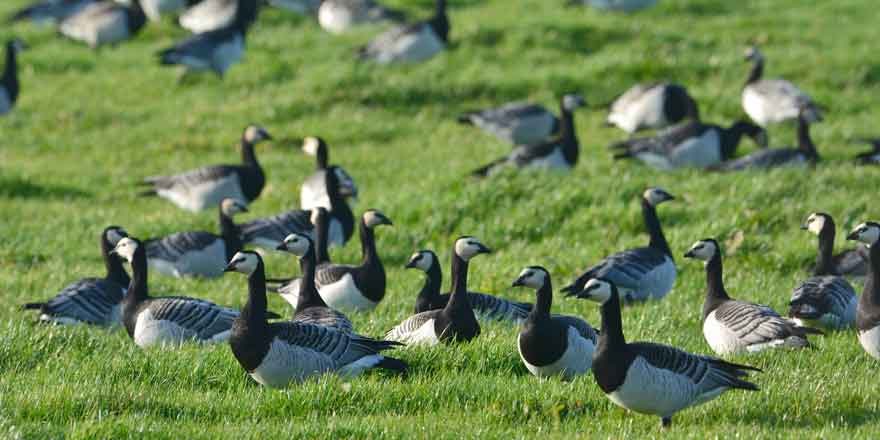
Birds of Clare Island: Barnacle Goose
15 August 2020Every day during Heritage Week (15-23 August) we introduce a different bird that populates Clare Island as it features in New Survey of Clare Island, vol. 9: Birds.
The ninth volume in the New Survey of Clare Island series focuses on the birds of Clare Island and is being released on 17 August as part of Heritage Week. Join us during Heritage Week and learn about some of the many birds that populate the island.
Today, you can read the entry on the Barnacle Goose as it appears in Chapter Two of New Survery of Clare Island, vol. 9: Birds. Chapter Two contains an inventory of the birds of Clare Island, and this is compared with the findings of the first survey conducted during 1909–11. The list comprises records that span the period from 1887 to 2018.
Barnacle Goose Branta leucopsis (Bechstein)
Annual winter visitor in the past. Now probably a regular winter and spring visitor in small numbers (PW).
Ussher (1912) said that this species was a ‘common winter visitor in flocks’ in ‘March and April and again in September, October, and November’. Ruttledge (1950) quotes P. McMahon that ‘70 to 100 winter’.
It appears that between 11 and 100 were found on Clare Island during the winter atlas (November 1981—February 1984) (Lack 1986). However, barnacle geese were not found on Clare Island during the survey in the spring of 1988 (Walsh and Merne 1988), nor in any of the regular subsequent surveys. Ruttledge (1994) does not include Clare Island in his review of the distribution of this goose in Galway and Mayo, nor was it detected in the most recent atlas survey (Balmer et al. 2013). Therefore, it appears that it may have departed from Clare Island as a regular visitor sometime between 1984 and 1988.
However, a flock of 13 was found on Kinatevdilla on 27 January 2006 and a flock of 40 was also found on the island by Malachy Mangan on 16 March 2018 (www.Irishbirding.com). A flock of about 25 birds was seen at Tore More in the spring of 2018 (PW). Patsy Winters believes that it is a regular winter visitor in small numbers, favouring one field in Tore More where it could easily be overlooked.
The absence of regular grazing geese from Clare Island is interesting as obligate herbivorous bird species generally, in terms of biomass, form a very small percentage of the estimated total of breeding land birds on the island (see Chapter 4). The very large increase in sheep numbers may be, at least, a partial explanation, though equally, in the case of geese, grazing could enable more efficient foraging by these birds.
Image credits: R.T. Mills
About the book:
Explore Clare Island’s avifauna, including the seabirds, land birds and waterbirds, and investigate the curious absence of breeding rooks from the island. This volume features a systematic list comprised of records of bird sightings that stretch from 1887 to 2018. The result of almost 20 years of fieldwork, it is an invaluable source for future monitoring of birds on Clare Island and beyond.
The first Clare Island Survey of 1909–11 was the most ambitious natural history project ever undertaken in Ireland and the first major biological survey of a specific area carried out in the world. The ‘Birds’ paper included in that survey was written by Richard J. Ussher and was based on fieldwork conducted on the island between 1909 and 1911. Ussher’s ‘Aves’ paper, however, also summarised details of the avifauna of a wider area in the west of Ireland—mainly the Counties of Galway and Mayo—a theme that was revisited several times by the late Major Robert F. Ruttledge. The current ‘Birds’ volume focuses exclusively on Clare Island and applies modern methods of census.
Buy the book here.
About the project:
The New Survey of Clare Island is a unique multidisciplinary project, the overall aim being to assess the environmental changes that have taken place over the last hundred years on Clare Island. Together with Robert Lloyd Praeger’s first Clare Island Survey, the New Survey provides an invaluable body of research informing future conservation of natural and built heritage of Ireland and Europe.



